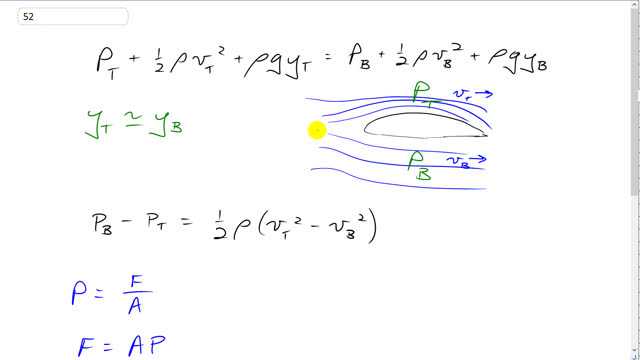
What is the lift (in newtons) due to Bernoulli’s principle on a wing of area if the air passes over the top and bottom surfaces at speeds of 280 m/s and 150 m/s respectively?

In order to watch this solution you need to have a subscription.
This is Giancoli Answers with Mr. Dychko. The lift force on this wing is gonna be due to the pressure difference between the bottom and the top of the wing. So we use Bernoulli's equation to figure that out. Here's a picture of the wing with some streamlines and showing that streamlines get closer together as the area gets squished on the top of this wing and so it has to go faster there and it's going slower on the bottom so we have pressure 'B' for bottom, pressure 'T' for top here. The vertical position of this point and this point are basically the same, they differ by the width of the wing which is insignificant so we'll say that y top basically equals y bottom in which case these terms are the same so they disappear and we'll find the pressure difference now. So we have pressure bottom minus pressure top if we bring this pressure top to the right side by subtracting it from both sides and we'll take this term to the left by subtracting it. And so we have v B is minus v B squared here and then we have a minus P T and I switched the sides around too. So we have pressure bottom minus pressure top equals one-half density of air which is a common factor that I factored out from these two v squared terms then times v T squared minus v B squared. So pressure is defined as force per area and then we can solve for force by multiplying both sides by area and then that means force is the area of the wing times the pressure applied to it. This is the net pressure, you know, we don't often say that but it really is the net pressure. So there's a pressure on the top and there's a pressure on the bottom but it's basically the resultant pressure, pressure difference in other words. And so we have this substituted in now for the net pressure and so that's one-half ρ times v T squared minus v B squared times the area of the wing. So that's 88.0 meters squared times a half times 1.29 kilograms per meter cubed— density of air— times 280 meters per second squared minus 150 meters per second squared which gives 3.2 times 10 to the 6 newtons.